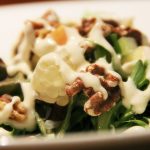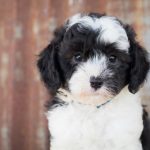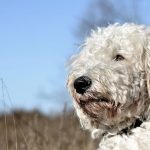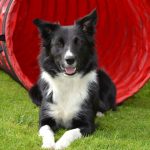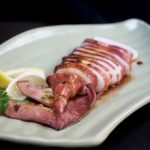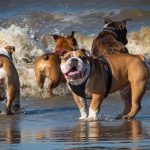
What happens when you pair an Australian Cattle Dog with a Pembroke Welsh Corgi? You get one adorable pup possessing the best traits of both breeds! This cross, also called the Cowboy Corgi is loved by many for its unique characteristics. Get to know more about this dog in today’s post.
History
Cowboy Corgis come from two breeds with interesting histories. The Australian Cattle Dog, also known as the Blue Heeler was first bred to herd cattle on ranches back in the 19th century. On the other hand, the Pembroke Welsh Corgis originated in the United Kingdom as cattle drivers and farm dogs.
The exact date and place of origin of Cowboy Corgis are not clearly identified. Like many crossbreeds, they are not officially recognized by major kennel clubs like the American Kennel Club.
Appearance
Many Cowboy Corgis look a lot like their Corgi parent. They inherit the size of the Corgi that grows only 10-15 inches at the shoulders when full-grown. Once they reach one year of age, they grow in their average size at only 25 to 30 pounds.
Some Cowboy Corgis have a docked tail while others don’t. If the Australian Cattle Dog’s breed is more prevalent, your Cowboy Corgi will likely have a tail. But like Corgis, all of them have an upright ear. Some would have a white face mask while others won’t.
While they got the same built as the Corgis, most of them sport the beautiful coat color and the facial features of the Australian Cattle Dog. The typical coat colors they have are sable, roan, and tri-color. They may also come in merle color, although it is quite rare.
The coat texture of Cowboy Corgis is either straight similar to the Heeler or shaggy much like the Corgi. This fur baby may have a short to medium coat length. It has a double coat that goes through seasonal shedding once or twice a year.
Personality
The traits of a Cowboy Corgi will depend on the parent with the more dominant gene. Both the Heeler and the Corgi are family-friendly although the Corgi is a more suitable option when you have kids at home.
Australian Cattle Dogs also have a reputation of being not so welcoming towards strangers. They have a tendency to bark towards new people coming to visit your home. But if this dog knows you well, he can be the most affectionate and most loving pooch you will ever meet.
This cross will be fairly easy to train, since it is a very intelligent one. In fact, both the Corgi and the Heeler are known for their independent nature. Dogs of this breed may have the tendency to chase especially small furry animals like their Australian Cattle Dog parents.
Cowboy Corgis could be as loyal and extremely alert as their Australian Cattle Dog parent. There is also a big possibility they will be as affectionate and loving as the Pembroke Welsh Corgi.
Grooming
One of the best things about Cowboy Corgis is that they are easy to groom despite the fact that they have a double coat. This comes as no surprise since the parents are both low-maintenance breeds. Do note, however, that this one is not a hypoallergenic pet. Like Corgis, it might produce moderate levels of dander.
The Cowboy Corgis need to be brushed once a week to keep their coat from dead hair. Regular brushing is essential to remove old or dead hair and also to prevent dander. The best brushes for their dense double coats are slicker brushes and de-matting comb. These tools are effective in removing knots and tangles.
Twice a year, expect your fur baby to shed its undercoat. The blowing of the coat normally happens during the spring and fall to prepare the body for the warmer or cooler months ahead.
During the shedding season, a de-shedding tool and a greyhound comb to brush out the strands of hair that could get stuck in the dog’s fur. Many pet parents use a furminator when grooming their pets during the shedding season.
Bathing the Cowboy Corgi should be done once a month or every six weeks. Keep the coat shiny by bathing your fur baby with a shampoo specially created for double-coated breeds. You can also find double-coat dog conditioners online and in pet stores.
Part of grooming this pooch involves regularly checking their mouth and ears. Dental hygiene is important in dogs as it is in humans to prevent periodontal diseases or inflammation of the supporting structures in some of the teeth. The ears should be always free from moisture that can lead to an ear infection.
Health
The Cattle Dog Corgi mix boasts a long lifespan. Both parents have an average lifespan of 12 to 14 years. This means it is a fairly healthy breed, although you have to keep an eye for some hereditary conditions.
Any breed of dog will be susceptible to certain conditions at some point in their lives. Keep an eye for the following problems often seen in the Australian Cattle Dog and Pembroke Welsh Corgi, because there is a possibility they may pass it on to their offspring:
- Progressive Retinal Atrophy – it refers to a set of heritable diseases similar to retinitis pigmentosa in humans. This condition can impinge on the dog’s vision and can even result in blindness if not treated. Before getting a Cowboy Corgi, have it screened for PRA to see if it is carrying the PRA gene from both the parents. A pup could come into PRA if both the parents are carriers of the autosomal recessive gene.
- Hip dysplasia- both the parents are prone to this condition and it’s possible the Cowboy Corgi will also acquire this too. Before getting a Cowboy Corgi, get the pup’s DNA test results to identify any chance of acquiring hip dysplasia. In dogs that did not inherit the condition, the best ways to prevent hip dysplasia is to exercise the pup in soft-grounded areas. If you adopted a dog and you are not sure if it has hip dysplasia, you may have him checked veterinary orthopedic specialist in your area.
- Intervertebral Disk Disease or slipped disc – since the Cowboy Corgis get many of the physical traits of the Corgis, it is not impossible they will acquire this condition. This refers to the deterioration of the intervertebral discs between the spinal column vertebrae. This problem affects many dogs with shorter legs and it can start from three years of age. It can be avoided by feeding a healthy and well-balanced diet because obesity contributes to increased chances of developing IVDD.
- Deafness – Australian Cattle Dogs are at high risk for congenital hereditary sensorineural deafness (CHSD) that affects breeds with a mask-free face. It is also common in dogs lacking the pigmented body patches. Hereditary hearing loss is diagnosed through Brainstem Auditory Evoked Response or BAER testing. It cannot be treated and dogs with hereditary deafness should no longer be bred to prevent it from passing the condition to their offspring.
Feeding
The recommended feeding amount for this dog will mostly be the same as the Corgi’s since they have the same structure and energy levels. Pups should be fed twice or thrice a day with a special formula created just for them. A one-fourth cup serving per meal will do.
As your pup grows older, you have to reduce the frequency of his meals to avoid the risk of obesity. Besides, dogs become less active as they grow old. You may give an adult Cowboy Corgi one meal, or divide the amount into two and offer it twice per day.
You may serve ¾ of a cup per serving but make it a point that your pooch needs moderate exercise per day. Dogs should be walked daily to prevent obesity that is already a major concern among Corgis.
This active pooch needs foods with the right blend of vitamins, minerals, and antioxidants. If you choose to feed dog food, check if it contains high-quality sources of protein like real chicken and beef.
Any breed of dog will benefit from a protein-rich diet with healthy amounts of healthy fats. You have to be a bit strict when it comes to feeding them. Like their Corgi parent, there’s a big chance they will love to eat and overfeeding can be a bit of a problem.
Dog foods are not all the same. There is a product created for different life stages. For example, there is a specific product you can only give pups while there are some that are only recommended for senior dogs.
If your Cowboy Corgi has a sensitive stomach and prone to skin allergy, work with a vet to find a diet that will work for your fur baby. Dogs with skin allergies should be given dog food rich in fatty acids or healthy oils like flaxseed. It promotes healthy skin and coat.
Dogs with sensitive stomachs should be fed easily digestible proteins and carbohydrates. Salmon is a better option for them, compared to chicken and beef that often causes food allergy in pets.
A Cowboy Corgi pup will have a more sensitive digestive system compared to the adult dog. It pays to feed dog food that only uses wholesome and quality protein. Since puppies are very active, they will benefit in vitamin-boosting ingredients.
For obese Cowboy Corgis, a vet may recommend dog food with a fat-reduced formulation. The reduced-variety generally contains less protein as well but it is loaded with nutrients, fatty acids, and antioxidants.
Cowboy Corgis may also be fed human foods like quality meat, fruits, and vegetables. Take note of foods to avoid like chocolates, garlic, onion, and macadamia.
Exercise Needs
This mix belongs to the herding group. Hence, expect this one to be active and full of energy. This playful dog requires lots of exercise. Since the Cowboy Corgi got the size of the Corgi, it can easily adapt to apartment living. It helps to have a small or medium-sized yard so your dog can run freely.
Exercise should be done a minimum of 20 minutes per day. Like Corgis, these hardy little dogs thrive in daily exercise to keep their weight under the control. Otherwise, they will suffer obesity.
This crossbreed has a reputation of a herding and chasing dog, but not really as a guard dog. If you are looking for a buddy with the skills to protect or serve as a watchdog, this one is not the right crossbreed to have.
To avoid this pet from herding other pets or people, it should be introduced to obedience training early in life. This involves teaching basic commands like “sit” and “stay.” When walking with your pooch, don’t forget to put it on a leash, especially if it was not yet trained to stop herding.
Regardless of the pet food brand you chose to give your Cowboy Corgi, make sure it is made of quality ingredients. Go for grain-free options and stay away from products containing animal by-products as the main ingredient.
Important Reminders Before Getting a Cowboy Corgi
A simple search online will show you breeders of Cowboy Corgi. But if you want to help reduce overpopulation in dogs, it will be better to find one from shelters. These dogs deserve the same love as breeds being sold by breeders.
Cowboy Corgi puppies usually cost $500-$750. They should already have their first rounds of shots and should be treated with a dewormer. The price depends on color and gender. More often than not, males can be more expensive than females.
Conclusion
A Cowboy Corgi, like many designer or mixed breeds, offers the best of both worlds. But you cannot predict their characteristics like in the case of purebred dogs. As always, we suggest you work with a reputable breeder if you are considering buying a pet.








